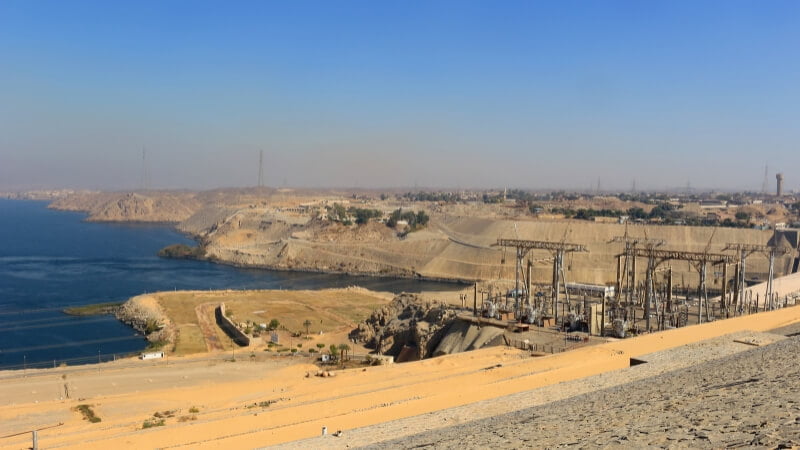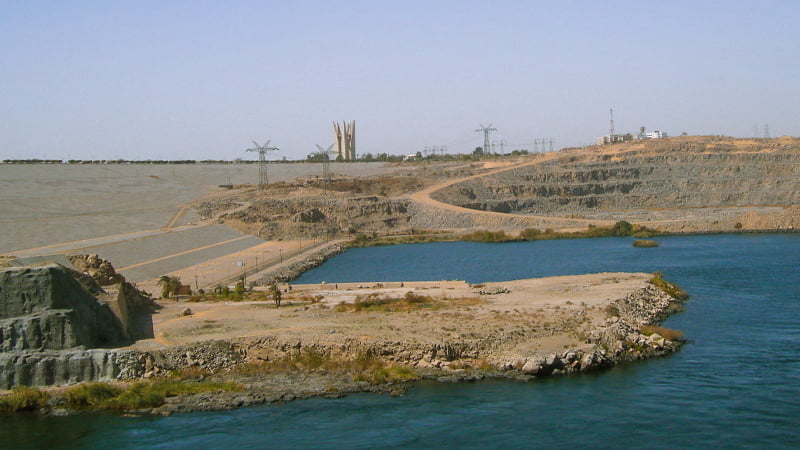The High Dam is one of the most famous landmarks in Aswan, next to the Abu Simbel Temple. The Aswan High Dam stands as an iconic testament to human ingenuity, forever altering the course of the Nile River and ushering in a new era of development in Egypt. This comprehensive article delves deep into the history, significance, and impact of the Aswan High Dam. From its inception to its far-reaching consequences, we explore how this engineering marvel has shaped the landscape and livelihoods of millions.
Aswan High Dam: Unveiling the Engineering Marvel
The Aswan High Dam, often called the High Dam, is a colossal concrete and steel structure stretching across the Nile River in southern Egypt. Spanning approximately 3,830 meters, this dam was conceived to harness the Nile’s power and address many challenges that had plagued the region for centuries.

Origins and Construction
The vision for the Aswan High Dam was born out of the need to control the annual flooding of the Nile, a natural phenomenon that brought both fertility and destruction to the land. The idea gained momentum in the mid-20th century, with construction commencing in 1960. It took a decade of relentless effort involving a workforce of thousands to complete this monumental project in 1970.
Impacts on Irrigation and Agriculture
One of the most transformative outcomes of the Aswan High Dam was its ability to regulate the flow of the Nile. This newfound control over water distribution allowed for a reliable irrigation system, bolstering agricultural productivity and enabling multiple harvests throughout the year. Lush fields replaced arid landscapes, and Egypt’s self-sufficiency in food production surged.
Electrifying the Nation
Beyond its agricultural benefits, the Aswan High Dam harnessed the Nile’s potential to generate electricity on an unprecedented scale. The dam’s hydroelectric power stations became the lifeblood of Egypt’s energy infrastructure, providing electricity to homes, industries, and cities nationwide. This surge in energy availability spurred economic growth and urbanization.
Sustainable Development: Balancing Progress and Preservation
The Aswan High Dam is not merely a symbol of engineering prowess; it represents a delicate equilibrium between progress and preservation. Its construction and operation have raised complex environmental and social considerations.
Environmental Resilience
While the dam brought undeniable advantages, it also profoundly altered the ecosystem. Water flow regulation led to changes in sediment deposition downstream, affecting soil fertility. Additionally, the dam’s reservoir became a habitat for various species, altering the local biodiversity. However, concerted efforts have been made to manage these ecological changes and protect the region’s delicate balance.
Socioeconomic Transformation
The Aswan High Dam’s positive impact extended beyond infrastructure and agriculture. It sparked a socioeconomic transformation, providing opportunities for education, employment, and improved healthcare. The dam’s reservoir created new fishing grounds, supporting local communities and diversifying livelihoods.

Exploring the Aswan High Dam: Frequently Asked Questions
How does the Aswan High Dam control the Nile’s flooding?
The dam’s intricate system of gates and sluices allows authorities to regulate water flow, releasing excess during flood seasons and conserving it during drier periods.
What challenges did the construction of the dam face?
The construction process was met with challenges such as relocating communities, managing construction materials, and navigating the Nile’s unpredictable nature.
Is the Aswan High Dam solely for irrigation and electricity?
No, the dam also controls sedimentation, provides flood protection, and offers opportunities for transportation and tourism.
How has the dam contributed to Egypt’s energy needs?
The hydroelectric power stations of the dam have significantly boosted Egypt’s energy capacity, reducing reliance on fossil fuels.
What measures are in place to mitigate the environmental impact?
Efforts include monitoring water quality, promoting sustainable fishing practices, and reforestation initiatives along the dam’s shores.
What is the significance of Lake Nasser?
Lake Nasser, the massive reservoir formed by the dam, has become a vital water source, a fisheries hub, and a picturesque backdrop for tourism.
Conclusion
The Aswan High Dam stands in the heart of Egypt’s arid landscape, a testament to human determination and cooperation. This engineering marvel has reshaped the Nile’s course, powering industries, nourishing fields, and improving lives. While challenges persist, the lessons learned from the dam’s construction and operation continue to guide sustainable development efforts worldwide.




